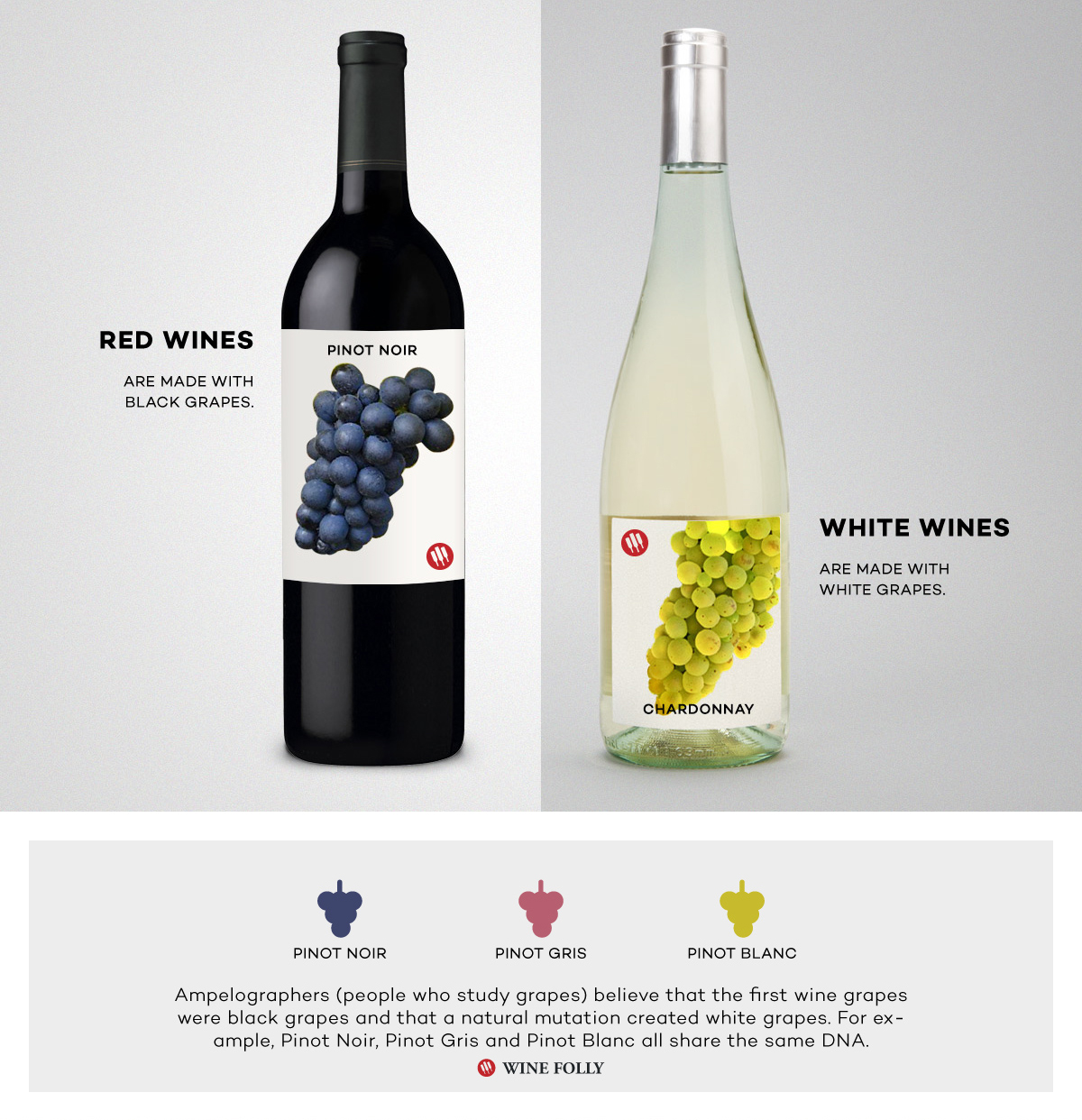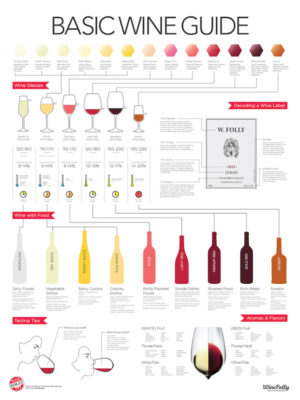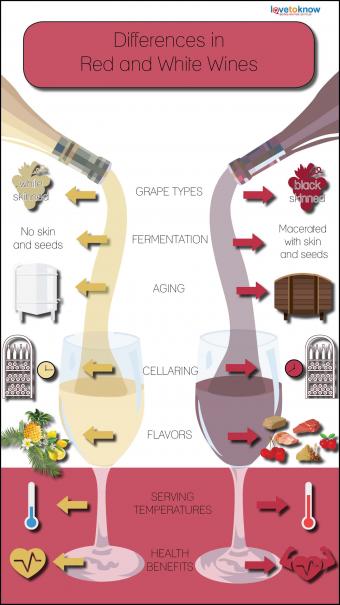Overview Of White Wine And Red Wine

White wine and red wine are two distinct types of wine with different characteristics. White wine is typically made from white or light-colored grapes. It is known for its crisp acidity and refreshing flavors, often showcasing citrus, floral, and tropical fruit notes. On the other hand, red wine is made from dark-colored grapes and gets its color from the grape skins during fermentation. Red wine is known for its bold flavors, including dark fruits, spices, and earthy undertones. The production process also differs, with red wine undergoing a longer fermentation and aging process than white wine. Overall, white wine and red wine offer unique taste profiles and can be paired with different types of food to enhance the dining experience.
White Wine: Characteristics And Production Process
White wine is known for its crisp acidity and refreshing flavors. It often showcases citrus, floral, and tropical fruit notes. White wine is typically made from white or light-colored grapes, which are gently pressed to extract the juice without any contact with the grape skins. The juice is then fermented at cooler temperatures to preserve its delicate flavors. The fermentation process is shorter compared to red wine, and white wine is usually aged for a shorter period as well. This production process allows white wine to retain its vibrant and fruity characteristics.
Red Wine: Characteristics And Production Process
Red wine is known for its bold flavors and deep red or purple color. It often exhibits notes of dark fruits, such as blackberries and cherries, along with hints of spices and earthy undertones. Red wine is made by fermenting the juice of dark-colored grapes along with the skins, which adds tannins and color to the wine. The skins are left in contact with the juice for a longer period of time compared to white wine, resulting in a fuller body and more complex flavors. The fermentation process is followed by aging in oak barrels or stainless steel tanks to enhance the wine’s characteristics.
White Wine Varieties

White wine offers a wide range of varieties, each with its own unique characteristics. Some popular white wine varietals include Chardonnay, known for its rich and buttery flavors; Sauvignon Blanc, which exhibits crisp and refreshing citrus notes; Chenin Blanc, often showcasing flavors of honey and tropical fruits; Pinot Blanc, known for its delicate and floral aromas; Pinot Gris, with its medium-bodied profile and notes of pear and apple; and Riesling, which can be either dry or sweet, offering flavors of green apple and apricot. These white wine varieties provide a diverse and enjoyable experience for wine enthusiasts.
Popular White Wine Varietals And Their Flavor Profiles
Chardonnay, known for its rich and buttery flavors, is one of the most popular white wine varietals. Sauvignon Blanc showcases crisp and refreshing citrus notes, while Chenin Blanc often exhibits flavors of honey and tropical fruits. Pinot Blanc is known for its delicate and floral aromas, while Pinot Gris offers a medium-bodied profile with notes of pear and apple. Riesling can be either dry or sweet, with flavors of green apple and apricot. These white wine varieties provide a diverse and enjoyable experience for wine enthusiasts.
Pairing White Wine With Food: Tips And Recommendations
When it comes to pairing white wine with food, there are a few tips and recommendations to keep in mind. The key is to match the flavors and intensity of the wine with the dish. For lighter dishes such as salads and seafood, opt for a crisp and refreshing white wine like Sauvignon Blanc. For richer and creamier dishes like pasta with cream sauce or roasted chicken, a fuller-bodied white wine like Chardonnay is a great choice. Additionally, consider the acidity of the wine when pairing with dishes that have a high fat content, as the acidity can help cut through the richness. Overall, experimenting with different pairings is a fun way to discover new flavor combinations.
Red Wine Varieties

Red wine offers a wide range of varieties, each with its own unique characteristics and flavor profiles. Some popular red wine varietals include Cabernet Sauvignon, known for its bold and full-bodied nature, with flavors of blackcurrant and dark chocolate. Merlot is another well-loved option, known for its smooth and velvety texture, with notes of plum and cherry. Pinot Noir is a lighter red wine, with delicate flavors of red berries and earthy undertones. Shiraz, on the other hand, is a spicy and rich red wine with robust flavors of blackberry and pepper. These red wine varietals provide a diverse range of options to suit different preferences and pair well with a variety of foods.
Popular Red Wine Varietals And Their Flavor Profiles
Some popular red wine varietals include Cabernet Sauvignon, known for its bold and full-bodied nature with flavors of blackcurrant and dark chocolate. Merlot offers a smooth and velvety texture with notes of plum and cherry. Pinot Noir is a lighter red wine with delicate flavors of red berries and earthy undertones. Shiraz is a spicy and rich red wine with robust flavors of blackberry and pepper. These red wine varietals provide a diverse range of options to suit different preferences and pair well with a variety of foods.
Pairing Red Wine With Food: Tips And Recommendations
When it comes to pairing red wine with food, there are a few tips and recommendations to keep in mind. First, consider the intensity of the red wine. Bold and full-bodied red wines like Cabernet Sauvignon pair well with equally robust dishes such as grilled steak or lamb. Lighter red wines, such as Pinot Noir, are better suited to lighter meats like roasted chicken or salmon. Additionally, consider the flavors and accents in the red wine. For example, a red wine with notes of pepper and spice, like Shiraz, can complement dishes with similar flavors, such as spicy sausage or peppercorn steak. Overall, the key is to find a balance between the flavors of the red wine and the flavors of the dish for a harmonious pairing.
Contrasting Characteristics

Contrasting Characteristics: Red and white wines possess distinct characteristics that set them apart. White wines tend to have a lighter body and higher acidity, resulting in a crisp and refreshing taste. They often showcase flavors of citrus, tropical fruits, and floral notes. On the other hand, red wines are typically fuller-bodied with lower acidity, offering a richer and more complex flavor profile. They often exhibit notes of dark fruits, spice, and earthiness. These differences in body, acidity, and flavor make red and white wines suitable for different occasions and pairings.
Contrasting Factors Between White And Red Wine
When comparing white and red wine, several factors set them apart. One of the main differences is the grape varieties used. White wine is often made from white or green grapes, while red wine is crafted from red or black grapes. Another contrasting factor is the production process. White wine is typically fermented without the grape skins, resulting in a lighter color and crisper taste. In contrast, red wine is made by fermenting the grape juice with the skins, leading to a deeper color and more robust flavor profile. These contrasting factors contribute to the distinct characteristics and experiences offered by white and red wines.
Health Benefits Of White Wine Vs. Red Wine
When it comes to the health benefits of white wine vs. red wine, red wine tends to have the upper hand. This is primarily because red wine is made with the skin of the grape, which contains resveratrol, a powerful antioxidant. Resveratrol has been linked to various health benefits, including reducing the risk of heart disease and inflammation. Additionally, red wine may also improve blood circulation and promote healthy cholesterol levels. While white wine also has some health benefits, such as promoting lung health and reducing the risk of certain cancers, red wine generally offers more significant advantages.
Wine Tasting And Serving Tips

Wine Tasting and Serving Tips:
When it comes to wine tasting, there are a few key tips to enhance your experience. Firstly, use the appropriate glassware for each type of wine. For white wine, choose a smaller, narrower glass to preserve its delicate aromas. For red wine, opt for a larger, rounder glass to allow the flavors to develop. Additionally, pay attention to the serving temperature. Whites should be chilled, while reds should be served at a slightly cooler room temperature. Finally, take your time to truly savor and appreciate the nuances of each wine, using all of your senses to fully enjoy the experience.
Proper Tasting Techniques For White And Red Wine
Proper tasting techniques can greatly enhance your experience when enjoying white and red wine. Begin by visually examining the color and clarity of the wine. Swirl the glass gently to release its aromas, and then bring it to your nose to inhale the scents. Take small sips, allowing the wine to coat your tongue, and pay attention to the flavors and texture. Notice the balance between sweetness, acidity, and tannins, and appreciate the lingering finish. By utilizing these techniques, you can truly appreciate the complexities and nuances of both white and red wines.
Serving Temperature And Glassware For White And Red Wine
When it comes to serving temperature and glassware, white and red wines have different requirements. White wines are best served chilled, typically between 45-55°F, to enhance their acidity and freshness. On the other hand, red wines are best served at room temperature, around 60-65°F, to allow their complex flavors and aromas to fully develop.
In terms of glassware, white wine glasses are generally smaller and narrower, while red wine glasses have a larger bowl to allow the wine to breathe and release its aromas. Stemless glasses are ideal for red wines as they minimize the impact of hand warmth on the wine, while traditional stemmed glasses are preferred for white wines. So, make sure to adjust the serving temperature and choose the appropriate glassware to fully enjoy the characteristics of both white and red wines.
Conclusion

In conclusion, white wine and red wine offer contrasting characteristics that can be appreciated by wine enthusiasts. While white wine is known for its refreshing acidity and fruit-forward flavors, red wine is characterized by its depth, complexity, and tannins. The choice between the two ultimately comes down to personal preference and the occasion. Whether it’s a crisp Sauvignon Blanc with seafood or a bold Cabernet Sauvignon with a steak dinner, both white and red wines have their place in enhancing our dining experiences. So, raise your glass and savor the unique qualities that each wine variety has to offer.
Key Differences Between White And Red Wine
White wine and red wine have several key differences that set them apart. First, white wine is made from light-colored grapes, while red wine is made from dark-colored grapes. This difference in grape color contributes to the distinct flavors and characteristics of each wine. White wine is known for its crisp acidity and fruity flavors, while red wine is characterized by its deeper, more complex flavors and tannins. Additionally, white wine is typically served chilled, while red wine is served at room temperature. These differences make white and red wine suitable for different occasions and food pairings.
Choosing The Right Wine For Different Occasions
When it comes to selecting the perfect wine for any occasion, there are no hard and fast rules. Personal preferences and tastes play a significant role in determining the best wine choice. However, there are some general guidelines that can help you make the right selection. For lighter and drier options, such as white wines, they are best suited for earlier parts of the evening or before the main course. On the other hand, red wines with their deeper flavors and complexity are ideal for accompanying hearty main dishes. Ultimately, it’s important to choose a wine that complements the occasion and enhances the overall experience.
FAQ About White Vs Red Wine: Contrasting Wine Varieties
Q: What are the main differences between white and red wine?
A: The main differences between white and red wine lie in the grape varieties used, the fermentation process, and the aging process. White wines are typically made from white or green grapes with the skins removed early in the winemaking process, while red wines are made from red or black grapes where the skins are kept on throughout fermentation, giving red wine its color and tannins.
Q: How does the taste of white wine differ from red wine?
A: White wines tend to be more light-bodied, crisp, and refreshing with flavors ranging from citrus and tropical fruits to floral and mineral notes. On the other hand, red wines are generally more full-bodied, richer, and complex with flavors of dark fruits like cherries and plums, along with earthy, spicy, and oaky undertones.
Q: Which foods pair better with white wine versus red wine?
A: White wine pairs well with lighter dishes such as seafood, poultry, salads, and creamy pasta sauces. Red wine complements heartier meals like red meats, stews, roasts, and aged cheeses. However, wine pairing preferences ultimately come down to personal taste.
Q: Are there any health benefits associated with drinking white or red wine?
A: Both white and red wines contain antioxidants like resveratrol, which may offer health benefits when consumed in moderation. Red wine, in particular, has been linked to potential heart-health benefits due to its higher concentration of antioxidants from grape skins.
Q: How should white and red wines be served and stored?
A: White wines are best served chilled, typically between 45-55°F (7-13°C), while red wines are best served at slightly cooler than room temperature, around 60-70°F (16-21°C). When storing wine, it’s important to keep bottles lying on their side in a cool, dark place with consistent temperature to preserve their quality and flavors over time.
